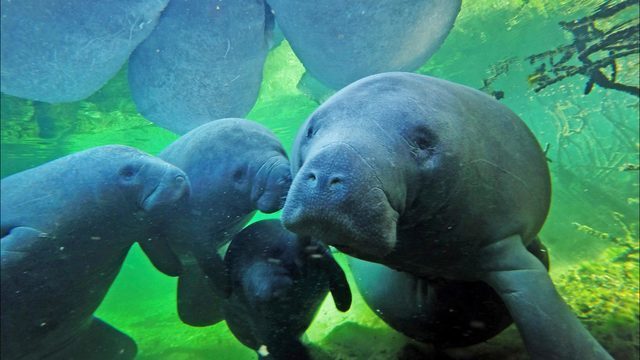Manatee Facts Part 4: Threats to Survival
Greetings! Here is part 4 of my Marvelous Manatee Facts for you!
Manatees are currently listed as threatened, meaning that we are currently in danger of becoming an endangered species within the foreseeable future. The following are major threats that manatees face every day…
- Cold Weather – In Florida during the winter months when it has been colder than normal, an increase in manatee deaths is common. Why? Because we manatees are warm-blooded marine mammals and we cannot tolerate water temperatures below 68 degrees Fahrenheit. Scientists believe we manatees cannot get our metabolisms high enough to make up for the heat loss in our surrounding waters.
- Red Tide – Red Tide is the name given to the growth or “blooms” of tiny organisms called dinoflagellates. These organism’s pigments can cause the water to look red, green or yellow. When these microscopic organisms gather in large groups, they release a toxic by-product. It is this by-product that affects the central nervous system of manatees and other sea life. The toxin is also absorbed into seagrass the main diet of manatees! As a result, manatees can quickly get sick or die from ingesting affected grasses. Scientists say that Red Tide and other algae blooms might be increasing in frequency due to climate change.
- Watercraft Collisions – Unfortunately, watercraft collisions are the leading cause of manatee deaths in Florida. We manatees can swim up to 20 miles per hour in short bursts, but we usually swim between 3 to 5 miles per hour. So, we’re rather slow moving and we need to surface for air. This event combined with the propellers of fast-moving watercraft and/or the crushing impact of the hull can kill manatees. It’s important for boaters to watch for circular impressions on the water surface. These circles are helpful markers telling you that a manatee is right under that water there!
- Pollution – Man-made products such as; pesticides, herbicides, and detergents, along with drainage of industrial chemicals can poison both the waterways and the food we manatees eat. In addition, oil spills are threats to all marine and estuarine habitats.
- Litter – Used fishing line, hooks, plastic six-pack holders and plastic bags are all dangerous threats to manatees and other forms of wildlife. Any type of entanglement from crab trap lines or ingestion of litter can easily cause injury or death to a manatee. In certain cases, a manatee can survive, however, its flipper may have to be amputated for its survival.
- Harassment – Harassment is any event that causes a manatee to change its natural behavior. This includes touching, chasing, or poking a manatee. It’s also very important not to feed or give a manatee water from a hose because this is considered harassment. Harassment can actually condition manatees to wander from their preferred habitat and it can also cause the separation of a mother and her calf.
- Flood Gates and Canal Locks – Unfortunately, a manatee can get crushed during the closing of a floodgate or canal lock, which is used to keep out salt water from fresh water. A manatee can also die from drowning caused by the rushing water and suction force created when a gate is opened. This force doesn’t let the manatee surface to breathe. The South Florida Water Management District along with the U.S. Army Corps of Engineers are now working on monitoring the gates and locks. They have created sensors that can tell when a manatee is swimming in the affected structures. These devices will “reverse” the gate action to prevent manatee deaths.
- Loss of Manatee Habitat – This is the most serious long-term threat that we manatees face. Factors affecting the loss of our habitat include; the growth in human population which contributes to pollution, litter and watercraft traffic. In addition, seagrass beds have been reduced or lost due to water pollution, herbicides, and dredging.
- Climate Change – This can be either natural or man-made. Research has shown that it is mostly man-made contributions to climate change that threaten manatees. Namely, as temperatures and sea levels continue to rise, seagrass beds (the primary food source for manatees), are impossible to grow where man-made sea walls and paving is taking place. Man-made bulkheads can also prevent the migration of manatees. As air temperatures continue to rise due to climate change, the frequency of more intense storms increases. As a result, these storms can displace or kill manatees. Finally, as the waters warm, there is an increase in toxic algae blooms, which can cause the increase in Red Tide outbreaks (See #2 above).
Stay tuned for more of my manatee facts for you coming up in a future blog!
If you are in Florida and you see a sick or injured manatee, please call the Florida Fish and Wildlife Conservation Commission at: 1-888-404-FWCC. They are the folks who are responsible for rescuing us in Florida.
Here’s the Save the Manatee Club link to learn more about us manatees …
Here’s a cool link for you to learn more about how we’re rescued and brought into rehabilitation …
~ Kobee Manatee
Related Posts
Cool and Interesting Facts about Florida Manatees (Part 1), October 22, 2015
Cool and Interesting Facts about Florida Manatees (Part 2), October 28, 2015
https://www.kobeemanatee.com/manatee-facts-part-3/ June 25, 2020
